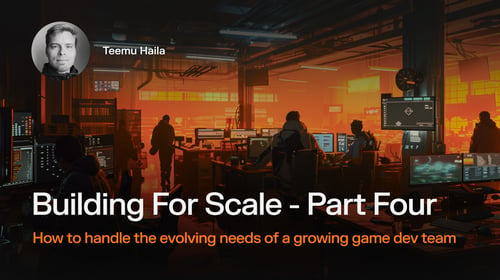
Building for Scale: Part Five - The side-effects of scaling revenue

Teemu Haila •
Our fourth and final Pillar of Scale concerns the reason why most commercial gamedevs are here in the first place: revenue. We all aspire to grow it, and celebrate when we do - but like each of the Pillars of Scale we deconstruct in this Metaplay Miniseries, it's not without its less sought-after side-effects. When game studios start making serious money, they need to ensure they're primed to maximize the opportunity in front of them by optimizing their game, unlocking new revenue streams, and guaranteeing long-term business continuity. Here, we discuss some frameworks for thinking about that to ensure successful game developers don't get caught out.
Recapping Pillars of Scale One, Two, and Three
Before we tackle the Fourth Pillar of Scale: Managing the side-effects of scaling company revenue , let's refresh our memory with the other three Pillars of Scale that led us up to this point. They are:
Pillar 01: How to handle the increasing number of players playing your game
Pillar 02: Managing the growing game complexity that comes with building a live-service game
Pillar 03: Handling the needs, priorities and workflows of a growing team and company

Each of the pieces above dives deep into the ramifications of what happens when the game you're working on starts growing.
Of course, scaling games is good news - and the reason why most of us are here in the first place. But if we're not ready for it, it can have unwelcome consequences.
We've all seen cases of games that launch to global fanfare, attracting millions of players only to suffer from their own success and crash and burn the next day. Server outages, cheating and fraud problems, or simply failing to make the most of the opportunity an influx of players can bring with it by, for example, not adequately planning a LiveOps strategy and tech infrastructure, can all leave players feeling flat, and studios with their tail tucked between their legs.
Metaplay's Building for Scale miniseries discusses some frameworks for thinking about these potential issues ahead of time to ensure that when they pop up, you're not just ready to resist them as problems, but have a set of tech, tooling, and processes in place that allows you to transform them into opportunities.
Our core thesis is that a couple of days' planning at the start of a project will let you build a long-term technological competitive advantage as you scale that means that unlike many of your peers, you'll be able to thrive - and not just survive.
With that said, it's time to dive into the most exciting pillar of all: Revenue.
The fourth Pillar of Scale: Managing the side-effects of scaling company revenue

More revenue. It just has a nice ring to it, doesn't it?
If you're making games, you've probably got to this point by employing an effective monetization strategy in both ads and in-app purchases.
And once the revenue machine starts rolling, you've likely done a good job at feeding that back into your growth levers to continue the vicious (but in this case, actually very friendly) circle. In the free-to-play games-as-a-live-service world, more revenue tends to mean a better return on ad spend (RoAS), which means you can then be even more competitive in your user acquisition (UA), which in turn brings more players and more revenue with it. And so the cycle goes on.
It's mostly good news. And of course, ad you start making money, the pressure ramps up to keep making even more. And that's the part that's worth planning for ahead of time.
Mo’ money, mo’ problems (but not necessarily)

I wouldn't usually be one to argue with Biggie, but in this case we might deem his interpretation of financial success to be a little short-sighted.
More money doesn't have to mean more problems, though indeed it could if we don't ask ourselves a crucial problem at the outset of our project.
That question is: 'Once I have a successful, revenue-generating game in place, how can I ensure I have the foundations in place to continue to grow it?'
Successful games and businesses are built on deep-rooted and scalable architecture and infrastructure.
Scrambling to build this later on down the line when you're already deep into your project sure is possible, but it's certainly not advisable.
The much better option is to have a robust, customizable, and extensible base you can easily add to and build on as you grow.
That way, when it comes to increasing your successful game's revenue even further by relentlessly optimizing your game, adding new revenue streams, and ring-fencing your brand and IP to guarantee business continuity, you won't need to reinvent the wheel.
You'll already have the structures in place that means you just have to add an extra spoke or two, or maybe, at a push, change a tire.
Money makes money: Where to focus once you've scaled
To be more specific, as your game's revenue grows a world of different opportunities and activities will open up to you - all with the goal of further scale in mind.
Your continued success will be based on which of those opportunities you choose, and which cards you play.
It's at this point that without realizing, some of the early decisions made at the start of a game development project could have serious ramifications on the possibilities open to you now.
The most successful studios and game developers keep all of their options open for as long as possible by choosing to build on scalable, extensible technology that will help them continue to deliver increased revenue even at significant scale.
The choices they made at the start of their development project make it easier to optimize their game later, unlock new revenue streams via new channels at game maturity, and they've guaranteed business continuity by protecting their brand and IP at all times.
That means that they've not unintentionally closed the door to continued revenue scaling by unwittingly making bad technological choices, and all of the avenues remain open for them to keep pursuing financial success.
Let's take a look at what they could be in a bit more detail.
Optimizing your game for more revenue
Data-driven LiveOps
LiveOps is the cornerstone for top-tier mobile games today. Indeed, mobile games can't succeed without a deep and engaging metagame that drives retention and engagement and steadily increases LTV over time.
The data-driven element of this is crucial, too. Developers intent on delivering more revenue need to be able to ship client-side updates without trawling through a cumbersome build-and-review cycle. Over-the-air update workflows with version control and rollback capabilities, like Metaplay's Game Config toolkit, are a necessity.
Ads or similar for low LTV cohorts
It's the nature of mobile gaming that the vast majority of your players won't be spenders.
You need to make sure you're monetizing those in some way - usually via ads. At scale, you don't just want to be serving ads to anyone. Your high-LTV players could be put off, and might be driven away from your game.
But that doesn't mean that you should leave revenue on the table by not targeting your low-LTV cohorts. To do that effectively, you need to build your game's economy on dynamic segmentation and personalization pipelines which will allow you to build bespoke gameplay experiences for whichever cohort you choose. Metaplay's segmentation tools are a handy and time-effective way to do that.
IAPs and/or subscriptions for high-value/paying players
Similar to above but opposite: with your big spenders, you need to make sure you're leaving no economic stone unturned and capturing any financial surplus they'd be willing to part with to enjoy your game.
Creating segmented buckets, analyzing user behaviour in those buckets, and extrapolating that to other buckets, areas, and monetization avenues is one way to do exactly that.
Off-app purchases for better revenue share and circumnavigation of high platform fees
Platform fees suck. And they've sucked for a long time. But fortunately we live in an age where we can now do something about it.
Building your game's shop off the app stores will help you increase your margin and reduce unit costs. At scale, the gains from this will be significant.
There are still other factors in play such as the platform's treatment of third-party stores, but over time, as scrutiny intensifies and regulation increases, the platforms have to start playing ball and being fair. When they do, developers that have built their shops on third-party stores will win. (If you're in the market for a web store and need a recommendation, then look no further than Appcharge.)
Unlocking new revenue streams to increase revenue potential
Regional and localized versions of your game, perhaps published by external vendors (in say China, India, EMEA)
Games that show promise in local markets and deliver exceptional revenue for their studios should be spread as far and wide as possible.
Geos like China and the Middle East are tough to crack for lots of reasons (that we won't go into here), but that doesn't mean that the possibility shouldn't be explored for studios looking to truly take their game global.
When that time comes, partnering up with a local distributor is advisable. This means your tech and infrastructure needs to be in a place that makes it easy for an external party to come and work with your project. Keep that in mind throughout - where possible, the use of homogenized, common tooling rather than custom-made, single-use tech will make this process much more straightforward for both you, and your new external partner.
At Metaplay, we've helped Dodreams publish their hit game Drive Ahead! in the Middle East via global publication house Sandsoft, and also work closely with China distribution partners Mygamez.
Licensing and merch
The biggest brands are more than games. Look to strike up licensing and merchandise deals with distributors and vendors who can help bring your brand to life beyond a phone screen.
Similarly to above, when the time comes to partnering with such providers, make sure you have an extensible platform they can work with in case they'd benefit from first-party access to your game project. Metaplay's permission management model is a good benchmark to follow in that respect.
GOING CROSS-PLATFORM (WEB, PC, CONSOLE - EVEN WEB3?)
At scale, it makes sense to try and existing audiences (and probably previously untapped audiences, too) in new places. Porting your mobile game to say web could be the logical first step, while bigger brands may even make the decision to go full cross-platform and publish on PC and console too.
At Metaplay, we helped Playsome publish their game Friends & Dragons on the web via our in-built WebGL compatibility.
When you start making your game, make sure the tech you're building it on will support multiple distribution channels later on if you seriously want to take it big.

Protecting your product, brand & IP to guarantee long-term business continuity
Source code access to all key tech
Most third-party tech that exists is built in a black-boxed vacuum that a game studio couldn't get its hands on even if it tried its hardest.
At scale, this causes problems. You need to know how the tech you're building on works so that a) you can fix it when it breaks and b) you can extend it with custom features.
Some externally-made tech, like Metaplay, is built with developers in mind. Metaplay ships as source code so studios will never have this problem, and can even be deployed into your own cloud - which brings us nicely onto our next point...
Self-hosting - especially of your game data
Self-hosting is another one of those things that's not critical at the start of a game project. Actually, self-hosting from the outset is more likely to slow you down, rather than speed you up.
At the start of your game project you just want to build, deploy, test, and improve. There's no need to be protective about where your game's hosted when you don't even have a product.
But that doesn't mean you shouldn't have a plan for how you're going to tackle that later.
The best course of action is to begin on a managed service plan which allows you to ship quickly and scale fast, like Metaplay's.
Then, when you're ready, migrate your game project to your own cloud for full control of your game and your data. That way you'll be safe in the knowledge that whatever happens to the vendor you're working with, your game will keep on running.
Fast and efficient incident response processes
At millions of dollars in daily revenue, expect millions of daily problems to have to deal with - especially in areas where you thought problems could never have existed before.
It's impossible to foresee what these problems might be and how they could take shape, so the best course of action is to ensure that you have a thorough incident response process in from the start - whether that's regarding reporting internal problems, external (vendor) problems, or player problems.
Be sure that each party you're working with, whether internally or externally, is aware of those processes too and what the SLAs might be. That way, you'll ensure that at scale, you'll be capable of quickly and efficiently putting out the fires that will inevitably pop up.
Automated testing pipelines to ensure no fatal bugs in builds slip through the cracks
This is a big topic with a short answer: All successful games at scale have to pass a thorough end-to-end testing process before being shipped.
Building these tools and pipelines yourself is time-consuming, and frankly, not very fun. (It's much better to be working on actual games.)
But it's one of those things that if you get wrong, it could have disastrous consequences for your brand and your business. You don't want to be shipping broken builds to players and risk losing them to a competitor. In today's competitive landscape the cost of switching has never been lower, and if a player has cause to jump to another title, then more than likely, they will.
We've built an extensive automated testing pipeline - complete with testing tools like our proprietary BotClient - which ensures that even at the most global scale, developers making games with Metaplay will never have to worry about something fatal slipping through the cracks.

Tackling a long list of challenges with a short moment's thought
Naturally, nobody is going to set out making a game with some of these issues in mind from the get-go.
As we've discussed, it's not a concern to think about, say, self-hosting, when all you need to do is deploy to a cloud (any cloud) and get quick feedback to help you prove a concept, and get to market fast.
But what you do need to think about is how to get to that point later on. How can you ensure that, for example in the case of migrating to self-hosting, the tech you've started building on supports that?
The same can be said for basically all of the topics listed here: data driven LiveOps, whale optimization, ads for non-payers, cross-platform support, regional and localized versions of your game, and source code access of the underlying tech which supports it.
Savvy studios don't worry about the practicalities of these at the start of a game project, but they do ensure they have the means in place to easily support their requirements when they need to. That allows them to build a technological competitive advantage, and means they're never left chasing their tail.
Such has been the theme of the entire Metaplay Miniseries of Building for Scale, which, after five instalments, we now bring to a close.
We'll be back soon with a complete version that brings together the key learnings from all four Pillars of Scale in one place. Be sure to sign up to our newsletter to be the first to read it.
In the meantime, why not try out the new playable version of the Metaplay LiveOps Dashboard, or, if you're feeling especially fruity, download the Metaplay SDK and take our whole tech stack for a spin. You won't regret it.



